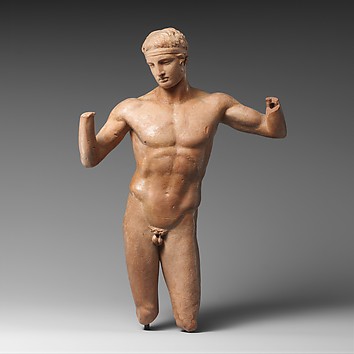 |
Stater of Mithridates VI Eupator (120-63 BC) |
ART
Antiquities:
Art & Design
During the Time
of Alexander
the Great
at the Met
(continued - Issue #2)
(From the Met Museum of Art NYC Exhibition:
Pergamon and the Hellenistic Kingdoms
of the Ancient World)
 |
Terracotta statuette of the Diadoumenos (youth tying a fillet around his head)
1st century b.c., Greek
|
Although terracotta was one of the most abundantly available and inexpensive materials of sculptural production in antiquity, it was used to make miniature copies less widely than might be expected. Apparently, only a few centers of production concentrated on this sculptural genre, and those that did limited their choices of subject considerably. The Greek city of Smyrna on the west coast of Asia Minor was among the most important copying centers, and a number of large- and small-scale replicas or variations of well-known statuary types, from both the Classical and Hellenistic periods, were made there.
 |
Bronze statuette of a veiled and masked dancer
Hellenistic, 3rd - 2nd century b.c.
|
 |
Bronze statue of Eros sleepingHellenistic period, 3rd - 2nd century b.c. |
This statue is the finest example of its kind. Judging from the large number of extant replicas, the type was popular in Hellenistic and, especially, Roman times. In the Roman period, Sleeping Eros statues decorated villa gardens and fountains. Their function in the Hellenistic period is less clear. They may have been used as dedications within a sanctuary of Aphrodite or possibly may have been erected in a public park or private, even royal, garden.
 |
Gold armband with Herakles knot |
 |
Pair of gold armbands |
 |
Glass situla (bucket) with silver handles |
Everted, angular rim, with thick vertical outer edge; slightly convex side tapering downwards; slightly domed bottom; two handle attachments, each pierced by two horizontal holes, project outward and upward from the edge of the rim on opposite sides of the bucket; two silver handles, each cut from a flat sheet into a semicircular arched strip, end in U-shaped round rods with decorative finials that are turned upward through the holes in the handle attachments.
The handle attachments are carved into rounded rectilinear blocks with a central upward finial with a raised outer surface, resembling a stylized palmette. On exterior, painted decoration extends from underside of rim to the bottom, comprising four main elements: at top, under rim, a continuous dog-tooth band in purplish red, with a thin line of light (Egyptian) blue below; on body, several irregular horizontal bands of small bud-like objects in shades of pinkish red, with details outlined in dark brown; on bottom, similar small objects, perhaps arranged in a rosette pattern; finally, two vertical stripes run down the sides of the bucket below the handle attachments, both are block-filled with purplish red paint, into which the lines of slender wavy tendrils have been incised freehand. Traces of gilding are visible on the stripes and elsewhere on the sides. The silver handles are fashioned into a stylized bud at the end of each rod.
Broken and repaired from numerous small fragments, with some losses and areas of fill; a few bubbles and many internal strain cracks; slight pitting and areas of whitish iridescent weathering; the silver handles are also broken and repaired.
The situla was used for cooling and serving wine at banquets. This one is made of almost colorless glass. It was cast and carved, and then bands of gilded and painted decoration were applied around the outside. The vessel is highly unusual in both shape and decoration, and few parallels in glass are known. It may, however, be compared with metal examples such as the bronze situla of the Prusias Find, which is displayed in the gallery for Greek art of the fourth century B.C.
 |
Medallion with relief bust of Athen
Hellenistic, 2nd century B.C. Greek
Medium: Gold, blue enamel
Dimensions: 4 3/8 in. (11.1 cm)
Classification: Gold and Silver
|
(Source: Photos by ARTSnFOOD staff and supplied by the Met Museum NYC, Any text came from the Met Museum press dept. and the wall plaques next to each work of art at the exhibition. All photos were taken with permission.)
Until later,
Jack
ARTS&FOOD is an online magazine dedicated to providing artists and collectors around the world with highlights of current art exhibitions, and to encourage all readers to invest in and participate in “The Joy of Art” and Culture. All Rights Reserved. All concepts, original art, text & photography, which are not otherwise credited, are copyright 2016 © Jack A. Atkinson, under all international, intellectual property and copyright laws. All gallery events', museum exhibitions', art fairs' or art festivals' photographs were taken with permission or provided by the event or gallery. All physical artworks are the intellectual property of the individual artists and © (copyright) individual artists, fabricators, respective owners or assignees.
Trademark Copyright Notice: ©ARTSnFOOD.blogspot,com, ©ARTSnFOOD,
©ARTS&FOOD, ©ARTSnFOOD.com, ©ARTSandFOOD.com, ©ART&FOOD, ©ARTandFOOD.com, ©ARTnFOOD.com)
No comments:
Post a Comment